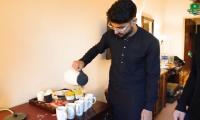As the yearly smog season approaches once again, the government has ordered the closure of all 19,000 brick kilns in Pakistan from October 20 to the end of December. The purpose is to limit dangerous carbon emissions from the kilns and improve air quality. However, brick-kiln owners and those who work at these kilns ask how they are to survive during this period. The average brick kiln worker, often employed alongside his whole family earns a few thousands rupees a month. The PTI government has recommended all brick kilns be altered to incorporate an internal zigzag structure along with air blowers. This will naturally take time. It is also unclear how many owners will be willing and able to make the expenditure required.
There is another dimension to this. Brick kilns are not the only source of air pollution in Lahore – which is usually the worst affected – or the rest of the country. According to the Pakistan Air Quality Initiative, a group set up by citizens to monitor air quality. Lahore’s air quality exceeds the danger level set by the country’s own official standards by 9 times. While we associate the greatest danger with the season between October and January, when moisture hangs in the air, PAQI which has used air monitors to measure air quality across Lahore notes that in 2017 there were two days when air was safe to breathe according to World Safety Standards. Other major cities in Pakistan – including Peshawar, Rawalpindi and Karachi – also suffer air pollution. According to experts, the reasons for this are the burning of crops to clear land, carbon emissions from vehicles, smoke released by factories, the burning of garbage and a variety of other factors. While brick kilns are indeed a problem, they are certainly not the sole culprits.
Air pollution is a leading cause of death and disease in the country. Children and the elderly are often most badly affected with hospitals reporting an insurge of patients on days when air quality is particularly poor. There has also been a dramatic rise in asthma in the country, notably among infants and children and during the smog season that now approaches once again people have been advised by authorities to remain indoors while PE lessons in schools are now routinely suspended. The problem is so severe that it requires a broad national policy to correct it. The lack of air quality monitors adds to the issue. This leaves us dependent on web-based apps and private monitors to know what we are breathing in. High levels of dangerous particulate matter affecting the lungs and respiratory system are the worst problem. Masks can help filter out some of this matter but not all of it. We need to understand that no human being can live without air. This is a national crisis which needs to be addressed at all levels with both short- and long-term measures put in place.
Country witnessed 432 violence-linked fatalities and 370 injuries among civilians, security personnel, and outlaws
During Raisi’s visit, Iran and Pakistan signed a total of eight accords on varying subjects to enhance cooperation...
Every year, millions of girls silently say goodbye to their education and the promise of a better career and get married
Ruling party emerged victorious in by-elections and as per unofficial results has won at least two out of five NA...
According to its organizers, the event now brings together around one billion people across 200 countries every April...
Pakistan’s nuclear programme, it would have threatened peace in the region because of its hegemonic designs







